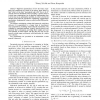Free Online Productivity Tools
i2Speak
i2Symbol
i2OCR
iTex2Img
iWeb2Print
iWeb2Shot
i2Type
iPdf2Split
iPdf2Merge
i2Bopomofo
i2Arabic
i2Style
i2Image
i2PDF
iLatex2Rtf
Sci2ools
IJCNN
2006
IEEE
2006
IEEE
Modeling Cortical Maps with Feed-Backs
Abstract— High-level specification of how the brain represents and categorizes the causes of its sensory input allows to link “what is to be done” (perceptual task) with “how to do it” (neural network calculation). More precisely, a general class of cortical map computations can be specified representing what is to be done as an optimization problem, in order to derive the related neural network parameters considering regularization mechanisms (implemented using so-called partial-differentialequations). The present contribution revisits this framework with three add-ons. It is generalized to a larger class of (non-linear) map computations, including winner-take-all mechanisms. The capability to represent standard “analog” neural network and guaranty their convergence, providing their weights are local and unbiased, is made explicit. The fact that not only one but several cortical maps can interact, with feed-backs, in a stable way is shown. Two experiments are provided ...
| Added | 11 Jun 2010 |
| Updated | 11 Jun 2010 |
| Type | Conference |
| Year | 2006 |
| Where | IJCNN |
| Authors | Thierry Viéville, Pierre Kornprobst |
Comments (0)

